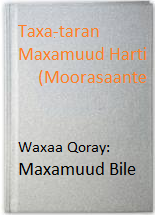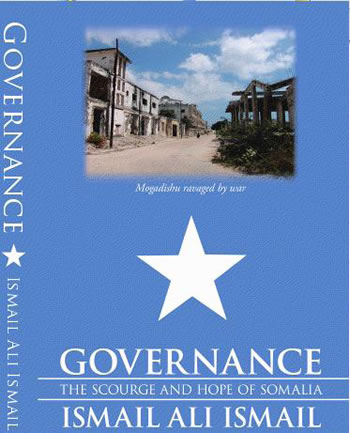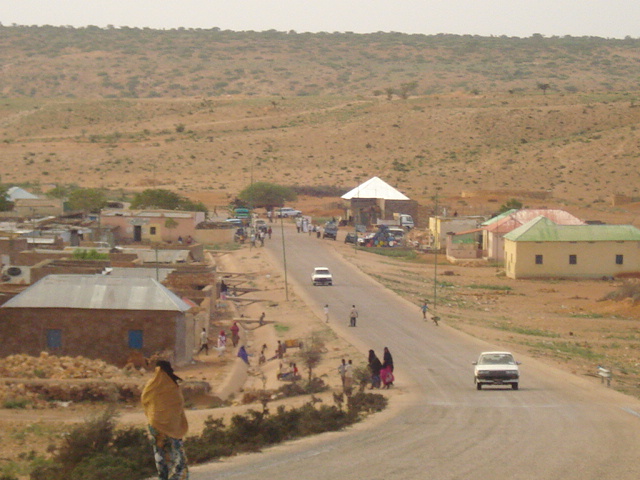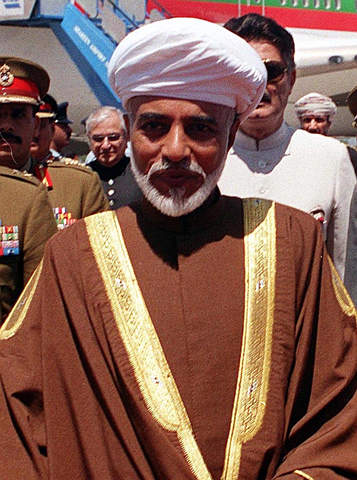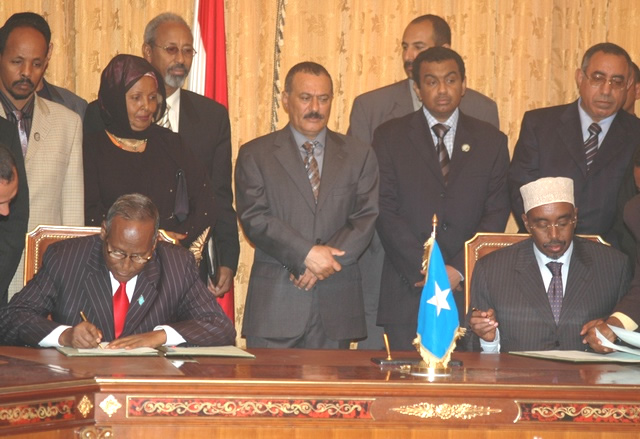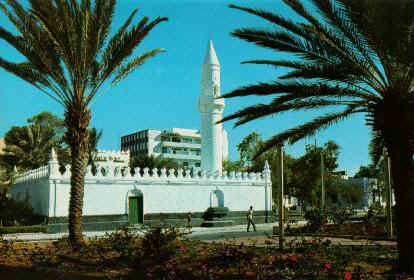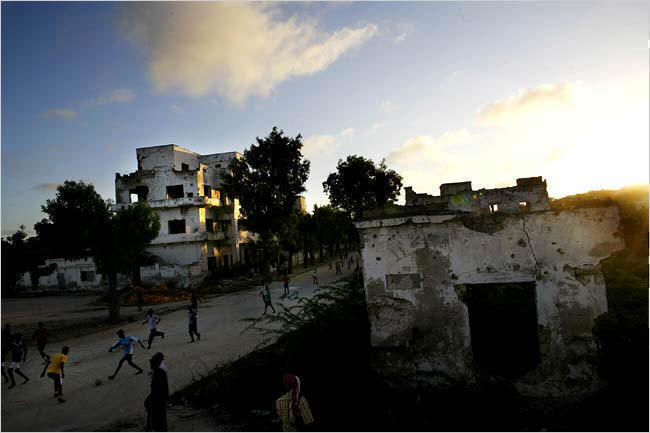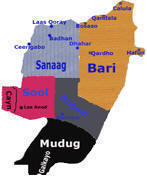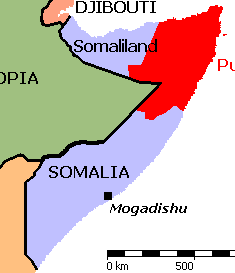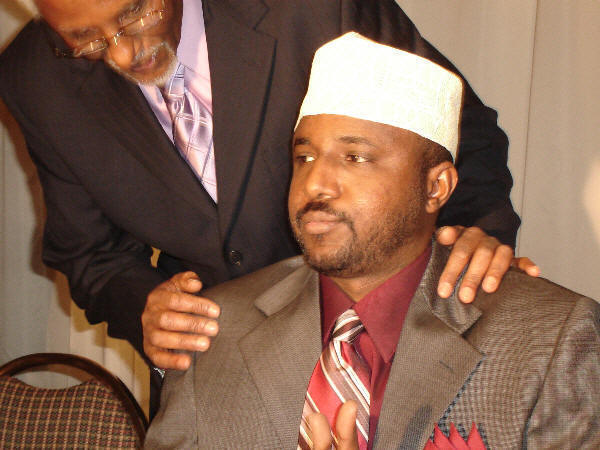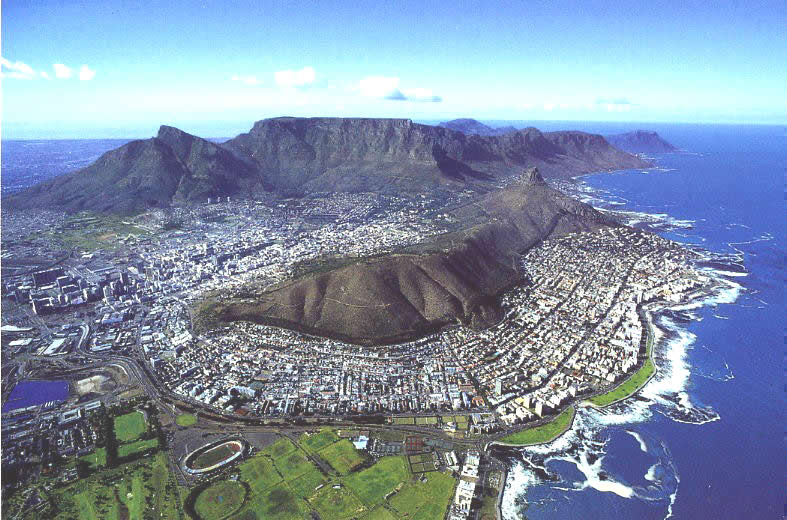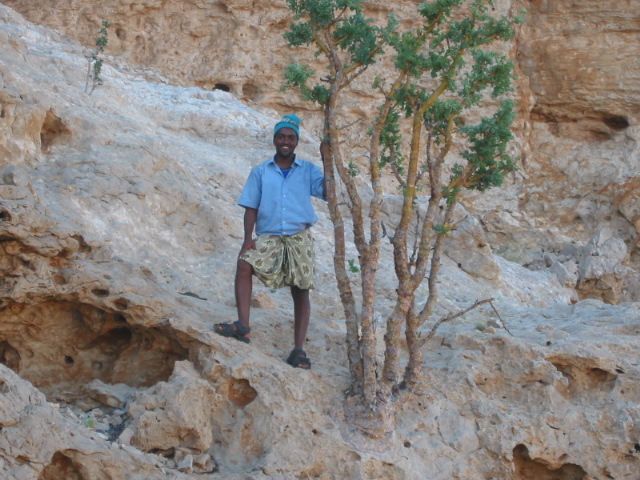
Part II
Lack of human intel hampered AQ hunt in
By Sean D. Naylor
Air Force Times
Tuesday, November 8, 2011
Read Part I: The Secret War: How U.S. hunted AQ in Africa
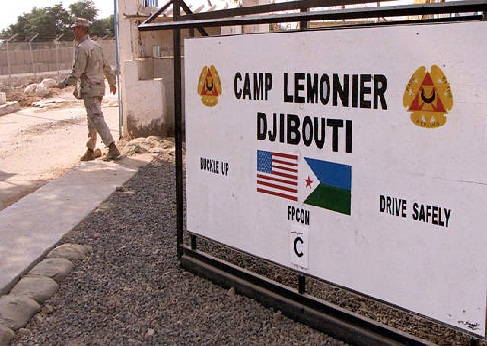
A U.S. Marine walks out of
The second in a series looking at
It was late summer in the hot, dusty Ethiopian town of
He tried to engage the men in conversation, but their tone turned bitter when the subject of the Ethiopian army arose.
�They`re the same as they were during the Dergue,� one man said angrily. �They`re f��� dogs. You understand? You understand what they do to us, to our women? Nothing has changed. Only now they wait until you turn your back.`�
This was the sort of candor Barcott craved as an intelligence officer, but he had a problem.
Despite leading a six-person human intelligence team with responsibility for the Horn of Africa � and with
�The Dergue?� he replied. �My interpreter looked at me like I was about to get shot or something, so I didn`t pursue that line of questioning,� he said in a recent interview with Army Times.
The conversation ended quickly, but Barcott`s interpreter wasn`t ready to let the matter lie. �Afterwards he`s like, `Listen, the Dergue was the communist regime that ran this place. � Everybody knows the Dergue. Come on, these are very basic things.`�
The exchange in Gode happened in 2004. The chastened Barcott had run head first into one of the major problems that plagued
�At that time, DoD had f�- all in terms of HUMINT in the Horn,� said an intelligence source with long experience in the region.
�At a very fundamental level, we simply lacked that baseline that we needed,� said a military targeting official. �We didn`t understand the culture, we didn`t understand the people � in a real sense we didn`t understand the players and how they related in the various organizations inside the various cities in the Horn.�
That part of Africa had gained sudden prominence in
This new intelligence did not come as a shock. Al-Qaida had already demonstrated its presence in the region with three devastating attacks: simultaneous suicide truck bombings on Aug. 7, 1998, that targeted the U.S. Embassies in Nairobi, Kenya, and Dar es Salaam, Tanzania, killing 223 people, most of whom were local civilians; and a suicide attack Oct. 12, 2000, that killed 17 sailors and badly damaged the destroyer Cole as it lay moored off the Yemeni port of Aden.
As they examined new streams of intelligence, what the spooks saw alarmed them. The flow of individuals from the Afghanistan-Pakistan theater to Yemen and Somalia amounted to no more than what a senior intelligence official described as �a trickle,� but what �worried� U.S. officials was �which kind of personalities were showing up,� said a special operations officer who had access to the intelligence.
The intelligence did not link al-Qaida supremo Osama bin Laden or his deputy Ayman al-Zawahiri to
The indications were that al-Qaida was moving people by boat from
�There were pretty good indications that it was small, seaborne [movement] that was way, way, way below the radar,� the special ops officer with access to the intelligence said. At first, �we weren`t sure if they were looking for a place to go to ground or � going to start more trouble,� he said. However, the officer added, �some intel indicated that al-Qaida was preparing another attack.�
As much as the movement of senior al-Qaida individuals, it was the network`s transfer of money into the region that set alarm bells clanging in Washington and elsewhere because that was considered a key indicator that operational planning was occurring, he said.
But with a war underway in
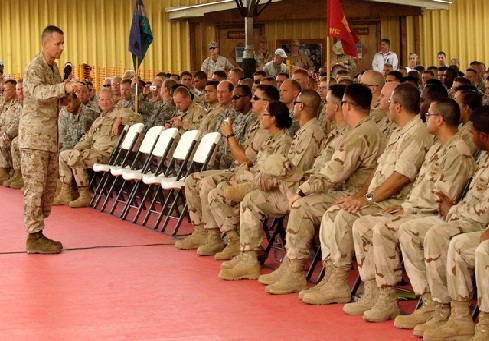
Chairman of the Joint Chiefs of Staff Marine Gen. Peter Pace (L) speaks to troops assigned to Combined Joint Task Force - Horn of Africa at
A third front
Based at
�CJTF�Horn of
By 2003, the CIA and the military`s Joint Special Operations Command were also establishing an operational presence in the Horn. Their mission was focused on killing or capturing al-Qaida in East Africa`s senior members, often referred to as high-value individuals, or HVIs. But veterans of that period, including senior members of CJTF-HOA, which rotated commanders at least once a year, differ as to the role of that thinly-resourced task force in that hunt and whether the Pentagon established it in part as a cover for JSOC or other covert activities in the region.
�[C]JTF-HOA, which was always led by a flag officer, was a very good and very mature yet under-resourced command that allowed us to have this blanket of cover, if you will, in order for us to do our HVI mission,� said the senior intelligence official.
The special ops source with firsthand knowledge of operations in the Horn echoed this view. When asked if CJTF-HOA was really a screen to hide JSOC and other special operations missions, he replied: �Yes, in a way.�
But senior leaders from the first years of CJTF-HOA`s existence denied this.
�It was not a cover for JSOC,� said the senior CJTF-HOA official from the period. Rather, he insisted, the hunt for al-Qaeda cell leaders �was absolutely in the mission set� of the task force. However, �that had to be done with a host nation lead,� the official said. �So we worked hard to facilitate the host nation`s ability to connect the dots on who the bad guys were and where they were, but for them to do the capturing or killing.�
However, retired Marine Lt. Gen. Sam Helland, who led CJTF-HOA from 2004 to 2005, said the manhunt for senior al-Qaida figures in the Horn was not his focus. The division between CJTF-HOA operations and the JSOC/CIA operations was like �the separation of church and state � they were state, I was church,� Helland said. �They did what they did � We stayed on the civil affairs side, drilling wells, building roads, schoolhouses, churches.�
A U.S. Central Command spokesman declined to release the 2002 operations order that established CJTF-HOA, saying it was still classified.
Lack of continuity
Barcott was leading a CJTF-HOA human intelligence team when he ran into difficulties in
He blamed the difficulty
�It`s the lack of continuity, structurally,� he said. �These places are complex, and coming in for six months, you`re only going to have a superficial understanding of what the hell`s going on, if you even have that.�
This problem hampered the hunt for the leading al-Qaida figures in
�You couldn`t make those last two leaps. [It was] frustrating as hell. It started out well intentioned as we were sinking a bunch of money into putting the toys in place, getting the right gear there to get some basic collection, but we didn`t have the fundamental understanding of either the physical area or the culture underneath it to really make all these things connect. It was one of these things where you felt like, `Jeez, we need to almost go back to school here.` �
What was missing �was human intelligence on the most fundamental level,� the targeting official said. �It was `do we really understand what they mean in this culture when they say this?` ... It`s not enough to simply translate something; you need to understand it.�
The search for a high-tech solution led to the daring mission in 2003 when a team of SEALs slinked ashore and planted a dozen disguised cameras, strategically placed to send pictures to
But some leaders didn`t understand that technology could not compensate for this lack of understanding, according to the targeting official. �You`ve got the three-star and the four-star who are yelling for results. They want something to happen in the next 15 minutes, and you come back and say, `Well, Jeez, boss, maybe it could happen in the next 15 months,` � the targeting official said. �Their answer would always be � the JSOC guy or the SOCOM guy or the CENTCOM guy � their answer would be, `Well, if you can`t do that, how about we put another platform out there?` And the answer was, `Well, no, the platform ain`t going to give me anything,` and of course they didn`t want to hear that.�
The
�Historically it hadn`t been a place where we had invested a lot of time and resources so you just didn`t have a lot of deeper historic relationships that had been built up, number one,� said Lt. Cmdr. Eric Greitens, a SEAL officer who commanded a joint special operations task unit in Manda Bay, Kenya, in early 2005, and whose book, �The Heart and the Fist,� deals in part with his experiences in the Horn. �Secondly, culturally it`s just not a place that many Americans have studied. The whole time I was there, I never met one area expert who I thought really understood the region.�
But the view that the intelligence available to
However, intelligence was �so hard to collect since no one speaks Somali or they don`t speak the dialects up in
The other senior CJTF-HOA official was more positive in his assessment of the intel that he and other task force leaders received on al-Qaida activity in the Horn.
�I thought both the human intelligence and signals intelligence that I got was exceptional, but everyone did not have access to that nor did they need access to it,� he said. �A lot of it was compartmentalized within the command.�
Task force leaders didn`t have everything they wanted in terms of information or intelligence assets, he acknowledged. �But it was a very large area of operation and there were two other fights going on simultaneously, so � [we were] very generously supported when [we] needed support,� he said. �[CENTCOM commander] Gen. [John] Abizaid worked very hard to give [us] the intelligence and the assets that [we] needed to be able to get the job done. But there was a limit to what was available. �
Indeed, officials said it was impossible to overstate the drain on ISR resources that the war in
�There were not enough assets in this half of the galaxy for what they were asking for in
But by 2006, senior military and intelligence leaders had become so alarmed by what they perceived to be a growing al-Qaida presence in the Horn of Africa and
�As our human intelligence network got better, our confidence level as to what these [al-Qaida] guys were doing really grew,� the intelligence official said. �So we argued and debated and finally won to get the right amounts of ISR � because in order to understand what the hell`s going on, you`ve got to build human intelligence networks, you`ve got to build technical networks � Predators, Global Hawks, etc. � to be able to understand the environment.
�We really took [a] risk in
Despite this, the senior intel official said, �ISR today remains a challenge in the Horn of Africa.�
Read Part I: The Secret War: How U.S. hunted AQ in Africa
|
|
 Sawirro Somaliya 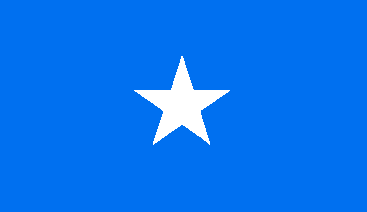 |
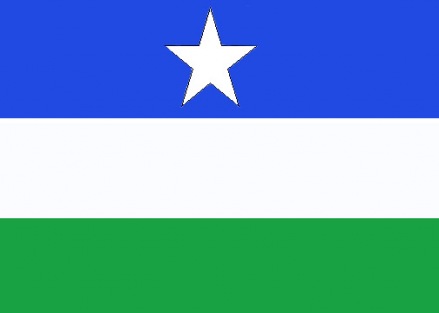
|
GOVERNANCE
The Scourge and Hope of Somalia A New Book By Ismail Ali Ismail 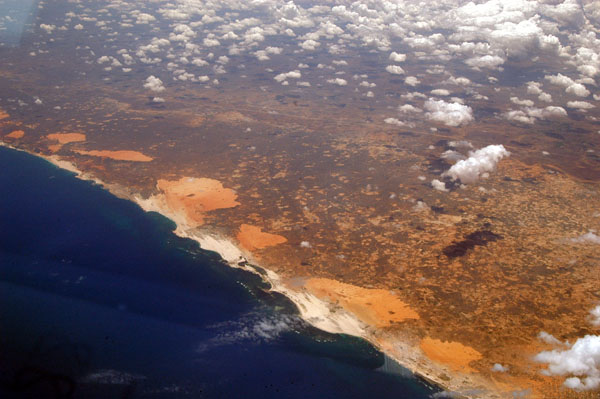 Which Way to the Sea, Please? By Nuraddin Farah Dhulkii Burcad-Badeedda .jpg) Budhcad Badeed Weli Qiil ma Leeyahay? 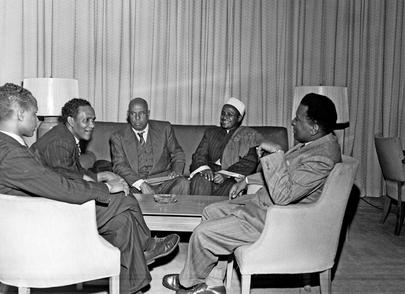 SYL LETTERS By A S Faamo |
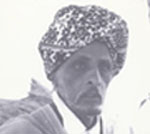 |
 |
© Copyright BiyoKulule Online All rights reserved�
Contact us [email protected] or [email protected] |
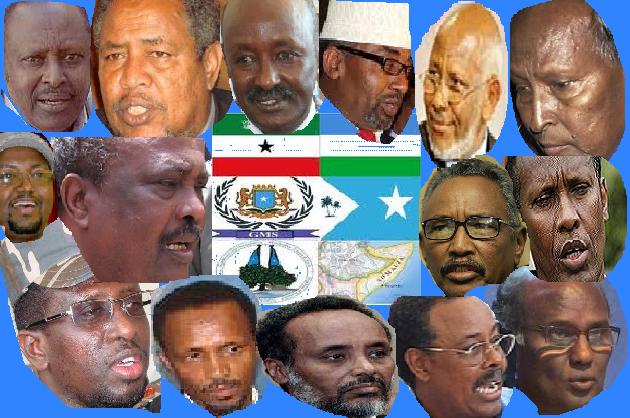

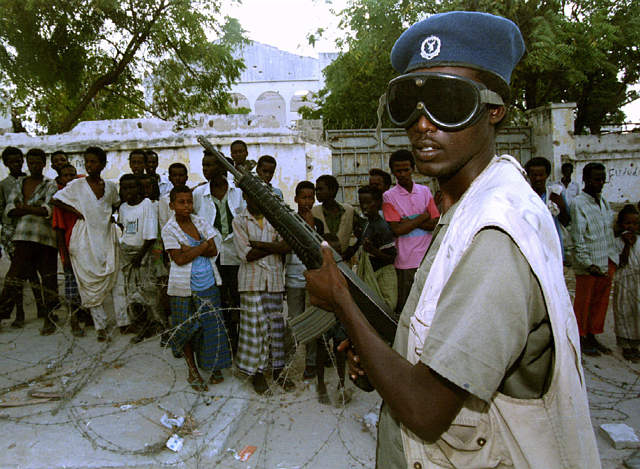

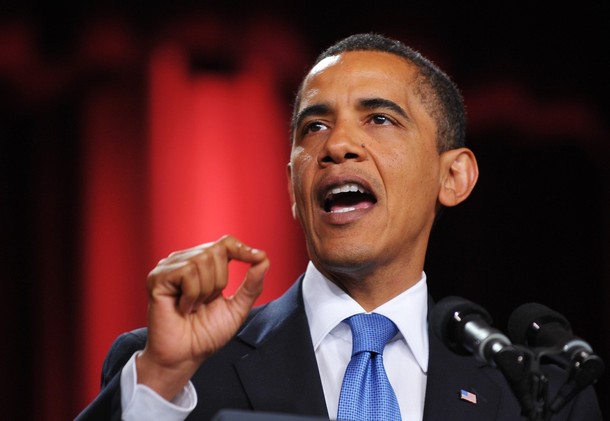
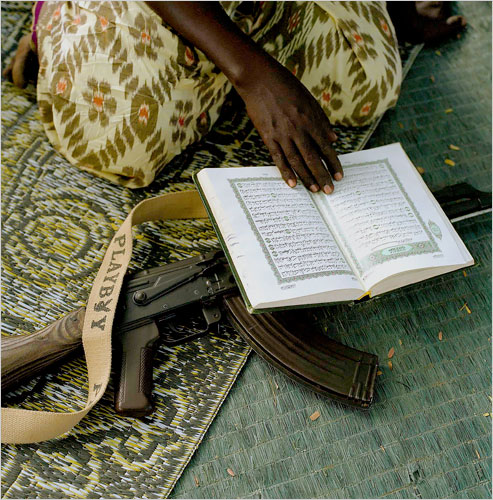

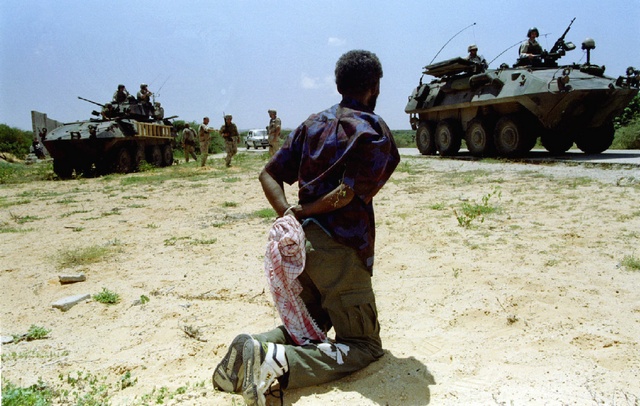
.jpg)
